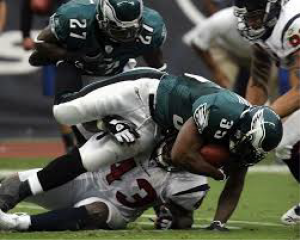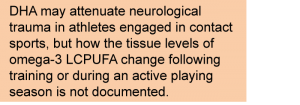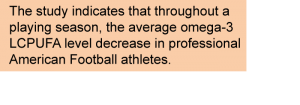Omega-3 Status during an American Football Playing Season
This article at a glance
- This is the first study that documents the status of omega-3 long-chain polyunsaturated fatty acids (omega-3 LCPUFA) in players of American Football, a sport where players receive many sub-concussive impacts over a playing season.
- Omega-3 LCPUFA levels decreased significantly over the course of a season.
- Although marked individual differences were observed, the study suggests that there is an opportunity for improvement in the monitoring and management of omega-3 status in elite athletes, with potential to influence inflammation and recovery from injury, and improve team performance.

Well-trained sportspeople and elite athletes voluntarily impose great physical demands on their bodies. Sports nutritionists are well informed of the specific requirements of carbohydrate and protein macronutrients for optimizing body composition, strength, stability, injury prevention and recovery from injury. It is thought that having the right levels of some important micronutrients such as vitamin D and omega-3 long-chain polyunsaturated fatty acids (omega-3 LCPUFA) may also influence athletic performance, or could provide positive effects in limiting injuries and improving the recovery from exercise and injuries. Practical applications for the use of micronutrients and vitamins in athletes are however still poorly developed, and the knowledge about any specific benefits that they might offer for athletes is still rudimentary.

Providing high quality nutrition has risen to the top of the agenda for high-performing sports teams and athletes in recent years. Elite teams, role models for a whole generation of sportspeople, are also continuously looking for an edge to slightly improve their competitive output. Although the scientific evidence for potential beneficial effects of omega-3 LCPUFA supplementation in athletes is still developing, for some aspects of endurance and strength performance increased dietary EPA/DHA intake appears effective. For example, in elite cyclists, increased omega-3 LCPUFA intake can improve maximal oxygen uptake and a lower heart rate during peak exercise. In endurance athletes, fish oil supplementation has been shown to reduce heart rate during sub-maximal exercise and improves the restoration of heart rate during recovery. New research is providing new insight in the modulatory role of omega-3 LCPUFA in muscle protein synthesis, although a role in young adults ingesting sufficient protein appears to be small. Importantly, a body of evidence demonstrating that increased omega-3 LCPUFA intake can significantly improve athletic performance is currently lacking.
Optimized nutrition is also actively being used to improve the recovery of sportspeople after exercise and competitive events. Of particular interest is the possibility for omega-3 LCPUFA to lower inflammation and reduce injury, and potentially help in the recovery from injuries. Following eccentric exercise, muscle soreness is markedly reduced in soccer players taking a fish oil-supplemented beverage, compared to a protein- or a carbohydrate-rich sports beverage. Blood concentration of creatine kinase, a marker of skeletal muscle damage following strenuous exercise, is also reduced in these professional players. Attenuation of neurological trauma from recurrent sports-related concussive and sub-concussive impacts is relevant to players in contact sports. To better understand the benefits omega-3 LCPUFA intake may provide to professional sportspeople, much more information has to be obtained about the actual tissue status of omega-3 LCPUFA in athletes, their requirements in preparation for a competitive sports event or over the course of a playing season, and any particular benefits in distinct sports.
American football requires a combination of strength, speed and body mass. High-level American football players undergo favorable changes in body composition throughout each single year, such as decreases in the percentage of body fat, increases in lean mass, and increased bone mineral content and density. American football players also receive a very high number of impacts to the head during trainings and matches, and traumatic brain injury from sub-concussive impacts is a risk in this sport. Neurological damage occurs in players during the playing season, as observed from markers of axonal injury. The frequency and severity of traumatic brain injury is also linked to the risk for dementia. For these reasons, the use of nutrition that may reduce the effects of sub-concussive brain injury is of significant interest in contact sports.
The supplementation of American football players with fish oil has previously been shown to be an effective way to increase EPA and DHA levels; in a period of two month, a daily dose of 2.2 g EPA+DHA increased EPA levels by ~3.6-fold and DHA levels doubled. Such increases can be obtained when baseline levels are relatively low, which is the case for most people. Achieving high tissue levels and maintaining such levels could be considered as a sensible approach to limit inflammation and tissue damage from injury, and favor healing and recovery from injuries. Studies that test protection against brain injury are difficult to carry out in humans, given the variable types, frequency and intensities of impacts that players can incur. One trial in American Football players that determined if omega-3 LCPUFA intake attenuated elevations of a biomarker of neurological injury has suggested a potential neuroprotective effect in sports-related concussion. Interestingly, a daily intake of 2 g/day appeared to provide a greater attenuation of neuronal injury than higher does, suggesting that an optimal dosage range needs to be appreciated and that higher EPA+DHA supplemental dosages are not necessarily better for limiting the effects of head trauma. Furthermore, although physical training itself is known to profoundly affect the fatty acid composition of membrane lipids in different tissues, a comprehensive understanding of the pattern of changes in specific fatty acids and their relation to sports recovery and performance has not emerged.
A publication by Blue and colleagues from the Applied Physiology Laboratory, at the Department of Exercise and Sport Science, and the Human Movement Science Curriculum, Department of Allied Health Science, University of North Carolina, Chapel Hill, NC, USA, reports the first study to document the changes in omega-3 status of professional American Football players during the playing season. The objective was to characterize body composition, omega-3 LCPUFA status, and levels of vitamin D throughout a competitive American Football season. Eighty-eight players of the National Football League volunteered to participate and were first evaluated during a routine health screening. Their average age was 24 years, and average weight and height were 108.8±19.4 kg and 186.8±5.9 cm, respectively. Baseline measurements were taken before the start of the playing season (August). and after 4 months (post season).
Given the logistical challenges to follow these players (due to common player transfers and time constraints around trainings and matches), only 42 of 88 players that initially volunteered could be monitored again at the end of the season. Body composition measures focused on the percent of body fat, which was determined by A-mode ultrasonography on skin-folds. A-mode ultrasonography measures the acoustic reflectance by adipose tissue and allows the determination of the relationship between the time (tissue depth) and the strength of the echo signals). Omega-3 LCPUFA levels were determined by an omega-3 bloodspot test, which reports the percent of omega-3 highly unsaturated fatty acids (HUFA) in the total blood HUFA. Information on the levels of vitamin D and blood lipids, as well as on injuries incurred during the season, were obtained from the players’ team physicians who took samples before and after the season during routine team medical testing. The changes in body composition, omega-3, and vitamin D, as well as the relationship between physiological variables, race, and injury prevalence were analyzed as secondary study outcomes.
At baseline, players had an average body fat percentage of 13.3 ± 6.4%. The level of omega-3 LCPUFA (EPA, DPA omega-3 and DHA) as percentage of the total highly unsaturated fatty acids (HUFA) in whole blood was 32.1 ± 8.8. No differences in these variables were found between players of different race (black, white, or other) or whether they had had an injury in the past year. No differences in baseline HDL-cholesterol, LDL-cholesterol, total cholesterol or glucose levels were found in players of different race or injury history. A moderate correlation between vitamin D and omega-3 status was found (r2=0.397), but there were no correlations between body fat and vitamin D or omega-3 levels.
There was a statistically significant average decrease of 2.47% in omega-3 LCPUFA content in HUFA during the playing season. Marked variation in this change was found between individual players, ranging from decreases of ~11% to increases of 10%. Vitamin D levels increased on average (increase of 9.03 ± 19.46 ng/ml). Body fat percentage was maintained.

The results of this descriptive cohort study indicate that, on average, the level of omega-3 LCPUFA in the tested NFL American Football players decreases during the playing season. There is room for increased omega-3 LCPUFA dietary intake. The results also suggest that some of the players did receive EPA and DHA through their diet or supplementation during the playing season. Of note, one difference at baseline was that white players had a higher vitamin D level (48.0 ± 13.7 ng/ml) than players categorized as black (27.1 ± 9.3 ng/ml) or other (23.3 ± 4.7 ng/ml), which may be related to sun exposure received from outdoor trainings. The study provides support that monitoring of athletes’ omega-3 and vitamin D status is of potential importance.
Some limitations need to be addressed in future studies; the sample size was small with a high drop-out which may have biased the results. The study did not report having measured dietary intake, or any other lifestyle change, before and during the study. Team wide recommendations of omega-3 supplementation individualized based upon pre-season values, as mentioned in the discussion of the report, suggest that some players may have taken omega-3 supplements. HUFA are generally defined as the 20- and 22-carbon highly unsaturated polyunsaturated acids comprised of the omega-3 HUFA EPA, DPA omega-3 and DHA, and the omega-6 HUFA 20:3 omega-6, arachidonic acid and 22:4 omega-6. The researchers chose to express omega-3 LCPUFA levels as percent of HUFA, which is not the most common way to express fatty acid content but provides a good indication of the fraction of omega-3 LCPUFA within the pool of HUFA that can be used to produce lipid mediators that are involved in tissue protection, and gives an idea of the balance of omega-3 LCPUFA with regard to the omega-6 LCPUFA. In this group of athletes, the average percentage was ~32%, which is low.
Possibly, the documentation of a reduction in omega-3 LCPUFA fatty acid levels in players may indicate that these fatty acids are actually being “used” during the season, resulting in decreased levels over time. Two likely fates whereby of EPA and DHA levels may decrease are lipid peroxidation following injury (even if recurrent and sub-clinical) and enzymatic conversion into lipid mediators that help control inflammation. While the study cannot exclude other fates of the fatty acids, such as their catabolism for energy generation, or redistribution from the circulation to other parts of the body, the observation that omega-3 LCPUFA levels can decrease is in line with results in animals showing decreasing tissue levels of docosahexaenoic acid (DHA) following traumatic head injury.

Given the growing interest in protecting health and potentially improving performance in sports, knowing an athlete’s omega-3 status is an important first step in beginning to evaluate the benefits omega-3 fatty acids may have in this developing arena. Fundamental studies that describe how the levels of omega-3 LCPUFA can be optimally maintained is also important for intervention trials with larger groups of participants, that are necessary to confirm the potential prophylactic neuroprotective potential of dietary and supplemental DHA intake in players of American Football and other contact sports.
Blue MN, Trexler ET, Hirsch KR, Smith-Ryan AE. A profile of body composition, omega-3 and vitamin D in National Football League players. J. Sports Med. Phys. Fitness 2018 Mar 1. [PubMed]
Worth Noting
A-mode ultrasound - Wagner DR. Ultrasound as a tool to assess body fat. J. Obes. 2013;2013(280713):1-9. [PubMed]
Crisco JJ, Fiore R, Beckwith JG, Chu JJ, Brolinson PG, Duma S, McAllister TW, Duhaime AC, Greenwald RM. Frequency and location of head impact exposures in individual collegiate football players. J. Athl. Train. 2010;45(6):549-559. [PubMed]
Da Boit M, Hunter AM, Gray SR. Fit with good fat? The role of n-3 polyunsaturated fatty acids on exercise performance. Metabolism 2017;66:45-54. [PubMed]
Fann JR, Riisgaard Ribe A, Schou Pedersen H, Fenger-Grøn M, Christensen J, M. EB, Vestergaard M. Long-term risk of dementia among people with traumatic brain injury in Denmark: a population-based observational cohort study. Lancet Psychiatry 2018;10 April. [Link]
Heaton LE, Davis JK, Rawson ES, Nuccio RP, Witard OC, Stein KW, Baar K, Carter JM, Baker LB. Selected in-season nutritional strategies to enhance recovery for team sport athletes: A practical overview. Sports Med. 2017;47(11):2201-2218. [PubMed]
Lalia AZ, Dasari S, Robinson MM, Abid H, Morse DM, Klaus KA, Lanza IR. Influence of omega-3 fatty acids on skeletal muscle protein metabolism and mitochondrial bioenergetics in older adults. Aging (Albany NY) 2017;9(4):1096-1129. [PubMed]
Lands B. A critique of paradoxes in current advice on dietary lipids. Prog. Lipid Res. 2008;47(2):77-106. [PubMed]
Macartney MJ, Hingley L, Brown MA, Peoples GE, McLennan PL. Intrinsic heart rate recovery after dynamic exercise is improved with an increased omega-3 index in healthy males. Br. J. Nutr. 2014;112(12):1984-1992. [PubMed]
Metherel AH, Buzikievich LM, Charkhzarin P, Patterson AC, Peel AC, Howorth AM, Kishi DM, Stark KD. Omega-3 polyunsaturated fatty acid profiling using fingertip-prick whole blood does not require overnight fasting before blood collection. Nutr. Res. 2012;32(8):547-556. [PubMed]
NFL American Football National Football League - https://www.nfl.com
Nikolaidis MG, Mougios V. Effects of exercise on the fatty-acid composition of blood and tissue lipids. Sports Med. 2004;34(15):1051-1076. [PubMed]
Oliver JM, Jones MT, Kirk KM, Gable DA, Repshas JT, Johnson TA, Andréasson U, Norgren N, Blennow K, Zetterberg H. Serum neurofilament light in American football athletes over the course of a season. J. Neurotrauma 2016;33(19):1784-1789. [PubMed]
Oliver JM, Jones MT, Kirk KM, Gable DA, Repshas JT, Johnson TA, Andréasson U, Norgren N, Blennow K, Zetterberg H. Effect of docosahexaenoic acid on a biomarker of head trauma in American football. Med. Sci. Sports Exerc. 2016;48(6):974-982. [PubMed]
Oliver JM, Anzalone AJ, Turner SM. Protection before impact: The potential neuroprotective role of nutritional supplementation in sports-related head trauma. Sports Med. 2018;48(Suppl 1):39-52. [PubMed]
Philpott JD, Donnelly C, Walshe IH, MacKinley EE, Dick J, Galloway SDR, Tipton KD, Witard OC. Adding fish oil to whey protein, leucine, and carbohydrate over a six-week supplementation period attenuates muscle soreness following eccentric exercise in competitive soccer players. Int. J. Sport Nutr. Exerc. Metab. 2018;28(1):26-36. [PubMed]
Tipton KD. Dietary strategies to attenuate muscle loss during recovery from injury. Nestle Nutr. Inst. Workshop Ser. 2013;75:51-61. [PubMed]
Trexler ET, Smith-Ryan AE, Mann JB, Ivey PA, Hirsch KR, Mock MG. Longitudinal body composition changes in NCAA Division I college football players. J. Strength Cond. Res. 2017;31(1):1-8. [PubMed]
Zebrowska A, Mizia-Stec K, Mizia M, Gasior Z, Poprzecki S. Omega-3 fatty acids supplementation improves endothelial function and maximal oxygen uptake in endurance-trained athletes. Eur. J. Sport Sci. 2015;15(4):305-314. [PubMed]
Wu A, Ying Z, Gomez-Pinilla F. Exercise facilitates the action of dietary DHA on functional recovery after brain trauma. Neuroscience 2013;248:655-663. [PubMed]
Yates A, Norwig J, Maroon JC, Bost J, Bradley JP, Duca M, Wecht DA, Grove R, Iso A, Cobb I, Ross N, Borden M. Evaluation of lipid profiles and the use of omega-3 essential fatty acid in professional football players. Sports Health 2009;1(1):21-30. [PubMed]

